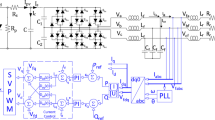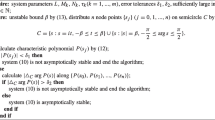Abstract
The multiarea Thévenin equivalent (MATE) solution framework is used in this work to combine several subsystems, which are solved using different multiple and non-multiple time-step sizes. In the proposed asynchronous MATE-multirate (A-MATE-multirate) solution, each subsystem is solved with the integration step size that is most adequate for its own internal time constants. This paper relaxes the requirement of previous multirate techniques, in which the solution time-steps of different systems must be multiples or submultiples of each other. To this end, this paper introduces the concept of asynchronous updating, in which each subsystem is updated according to its own internal clock. This updating process is performed in a closed-form solution, with external subsystems represented by their interpolated Thévenin equivalents. Interpolation with future values without using extrapolation is possible in the electromagnetic transients program solution because the history source for future time-steps is calculated at previous time-steps. The exchange of information between subsystems is conditioned using filters to avoid numerical problems during the decimation of the fast subsystems and the interpolation of the slow subsystems. The effectiveness of the proposed methodology is verified with examples using multiple and non-multiple time-step sizes.





















Similar content being viewed by others
References
Watanabe M, Karplus M (1995) Simulations of macromolecules by multiple time-step methods. J Phys Chem 99:5680–5697. https://doi.org/10.1021/j100015a061
Brooks BR et al (2009) CHARMM: the biomolecular simulation program. J Comput Chem 30:1545–1614. https://doi.org/10.1002/jcc.21287
Kranc GM (1957) Input–output analysis of multirate feedback system. IRE Trans Autom Control AC 3:21–28. https://doi.org/10.1109/TAC.1957.1104783
Kalman RE, Bertram JE (1959) A unified approach to the theory of sampling systems. J Frankl Inst 267:405–436. https://doi.org/10.1016/0016-0032(59)90093-6
Gear CW (1974) Multirate methods for ordinary differential equations. Department of Computer Science, University of Illinois at Urbana-Champaign, Report UIUCDCS-F-74-880. Accessed 09 Mar 2020
Heffernan M, Turner K, Arrillaga J, Arnold C (1981) Computation of AC–DC system disturbances—Part I. Interactive coordination of generator and converter transient models. IEEE Trans Power App Syst 100:4341–4348. https://doi.org/10.1109/TPAS.1981.316825
Reeve J, Adapa R (1988) A new approach to dynamic analysis of AC networks incorporating detailed modelling of DC systems I principles and implementation. IEEE Trans Power Deliv PD 3:2005–2011. https://doi.org/10.1109/61.194011
Anderson GWJ, Watson NR, Arnold CP, Arrillaga J (1995) A new hybrid algorithm for analysis of HVDC and FACTS systems. Proc IEEE of the Int Conf Energy Manag Power Deliv 2:462–467. https://doi.org/10.1109/EMPD.1995.500772
Semlyen A, de León F (1993) Computation of electromagnetic transients using dual or multiple time steps. IEEE Trans Power Syst 8:1274–1281. https://doi.org/10.1109/59.260867
Moreira F, Martí J (2005) Latency techniques for time-domain power system transients simulation. IEEE Trans Power Syst 20:246–253. https://doi.org/10.1109/TPWRS.2004.841223
Moreira FA, Martí JR, Zanetta LC, Linares LR (2006) Multirate simulations with simultaneous-solution using direct integration methods in a partitioned network environment. IEEE Trans Circuits Syst I Regul Pap 53:2765–2778. https://doi.org/10.1109/TCSI.2006.882821
Martí JR, Linares LR, Calviño J, Dommel HW, Lin J (1998) OVNI: an object approach to real-time power system simulators. In: POWERCON '98. 1998 international conference on power system technology, Beijing, China. https://doi.org/10.1109/ICPST.1998.729230
Linares LR (2000) OVNI, object virtual network integrator: a new fast algorithm for the simulation of very large electric networks in real time. Ph.D. dissertation, Dept. Elect. Comput. Eng., Univ. British Columbia, Vancouver, BC, Canada
Martí, JR, Linares, LR, Hollman JA, Moreira FA (2002) OVNI: integrated software/hardware solution for real-time simulation of large power systems. In: Power systems computation conference (PSCC), Seville, Spain. https://www.semanticscholar.org/paper/OVNI%3A-Integrated-Software%2FHardware-Solution-for-of-Mart%C3%AD-Linares/a3b56f85b68014d204316e2c48bab84c94e4b754
van der Meer AA, Gibescu M, van der Meijden MAMM, Kling WL, Ferreira JA (2015) Advanced hybrid transient stability and EMT simulation for VSC-HVDC systems. IEEE Trans Power Deliv 30:1057–1066. https://doi.org/10.1109/TPWRD.2014.2384499
. Haddadi A, Mahseredjian J and Dufour C (2016) Time warping method for accelerated EMT simulations. In: Power systems computation conference (PSCC), Genoa, Italy, 20–24. https://doi.org/10.1109/PSCC.2016.7541022
IEEE Task Force on Interfacing Techniques for Simulation Tools et al. (2018) Interfacing power system and ICT simulators: Challenges, state-of-the-Art, and case studies. IEEE Trans Smart Grid 9:14–24. https://doi.org/10.1109/TSG.2016.2542824
Duan T, Shen Z, Dinavahi V (2019) Multi-rate mixed-solver for real-time nonlinear electromagnetic transient emulation of AC/DC networks on FPGA-MPSoC architecture. IEEE Power Energy Technol Syst J 6:183–194. https://doi.org/10.1109/JPETS.2019.2933250
Dommel HW (1996) EMTP Theory Book, 2nd edn. Microtran Power System Analysis Corporation, Vancouver
Kron G (1963) Diakoptics piecewise solution of large-scale systems. MacDonald, London
Ho CW, Ruehli AE, Brennan PA (1975) The modified nodal approach to network analysis. IEEE Trans Circuits Syst 22:504–509. https://doi.org/10.1109/TCS.1975.1084079
Proakis JG, Manolakis DG (2006) Digital signal processing, 4th edn. Prentice Hall, New Jersey
Schafer RW, Rabiner LR (1973) A digital signal processing approach to interpolation. Proc IEEE 61:692–702. https://doi.org/10.1109/PROC.1973.9150
Schafer RW (2011) On the frequency-domain properties of Savitzky–Golay filter. Digital signal processing and signal processing education meeting (DSP/SPE), Sedona, AZ. 54–59. https://doi.org/10.1109/DSP-SPE.2011.5739186
Matlab (2015b) The MathWorks, Inc., Natick, Massachusetts, United States
Galván VA, Martí JR, Dommel HW, Gutiérrez-Robles JA, Naredo JL (2016) MATE multirate modelling of power electronic converters with mixed integration rules. In: Power systems computation conference (PSCC) Genoa, Italy, 20–24. https://doi.org/10.1109/PSCC.2016.7540945
Moreira FA, Marti JR (2003) Latency suitability for the time-domain simulation of electromagnetic transients through network Eigen analysis. In: Proceedings of. International Conference on Power Systems Transients (IPST), in New Orleans, USA. https://ipstconf.org/papers/Proc_IPST2003/03IPST03a-04.pdf
Hollman JA, Martí JR (2010) Step-by-step eigenvalue analysis with EMTP discrete-time solutions. IEEE Trans Power Syst 25:1220–1231. https://doi.org/10.1109/TPWRS.2009.2039810
de Siqueira JCG, Bonatto BD, Martí JR, Hollman JA, Dommel HW (2015) A discussion about optimum time step size and maximum simulation time in EMTP-based programs. Int J Electr Power Energy Syst 72:24–32. https://doi.org/10.1016/j.ijepes.2015.02.007
Martí JR, Lin J (1989) Suppression of numerical oscillations in the EMTP. IEEE Trans Power Syst 4:739–747. https://doi.org/10.1109/59.193849
Author information
Authors and Affiliations
Corresponding author
Additional information
Publisher's Note
Springer Nature remains neutral with regard to jurisdictional claims in published maps and institutional affiliations.
Rights and permissions
About this article
Cite this article
Galván-Sánchez, V.A., Martí, J.R., Bañuelos-Cabral, E.S. et al. An asynchronous MATE-multirate method for the modeling of electric power systems. Electr Eng 103, 993–1007 (2021). https://doi.org/10.1007/s00202-020-01128-x
Received:
Accepted:
Published:
Issue Date:
DOI: https://doi.org/10.1007/s00202-020-01128-x




